Business Statistics: Analyzing Transport Data for New South Wales
VerifiedAdded on 2023/06/05
|10
|2356
|185
Report
AI Summary
This report presents an analysis of transport data from New South Wales, focusing on identifying frequently used transport modes and understanding passenger preferences. The analysis utilizes two datasets to answer specific research questions related to transport patterns. Key findings include that buses are the most frequently used mode of transport, although no single mode accounts for over 50% of total usage. The report also examines passenger travel patterns between different stations, suggesting potential areas for infrastructure development, such as building an underground railway line from Bankstown to Central. Hypothesis testing reveals no significant difference in tap on and tap off counts, nor in transport mode preferences between males and females. The report concludes with recommendations for the New South Wales government based on the data analysis, emphasizing strategic investment in transport infrastructure to improve passenger experience and optimize resource allocation. Desklib provides access to this solved assignment and many other resources for students.
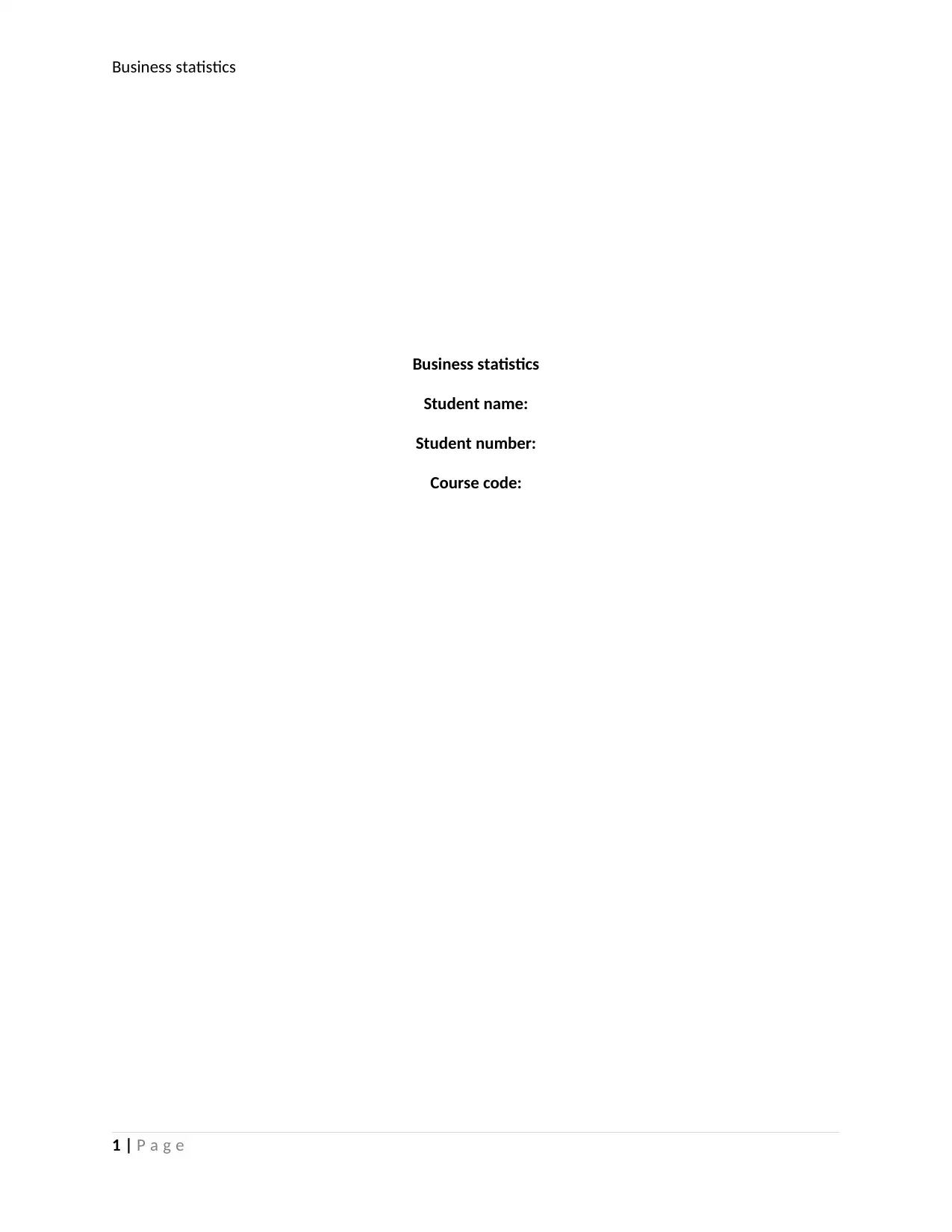
Business statistics
Business statistics
Student name:
Student number:
Course code:
1 | P a g e
Business statistics
Student name:
Student number:
Course code:
1 | P a g e
Paraphrase This Document
Need a fresh take? Get an instant paraphrase of this document with our AI Paraphraser
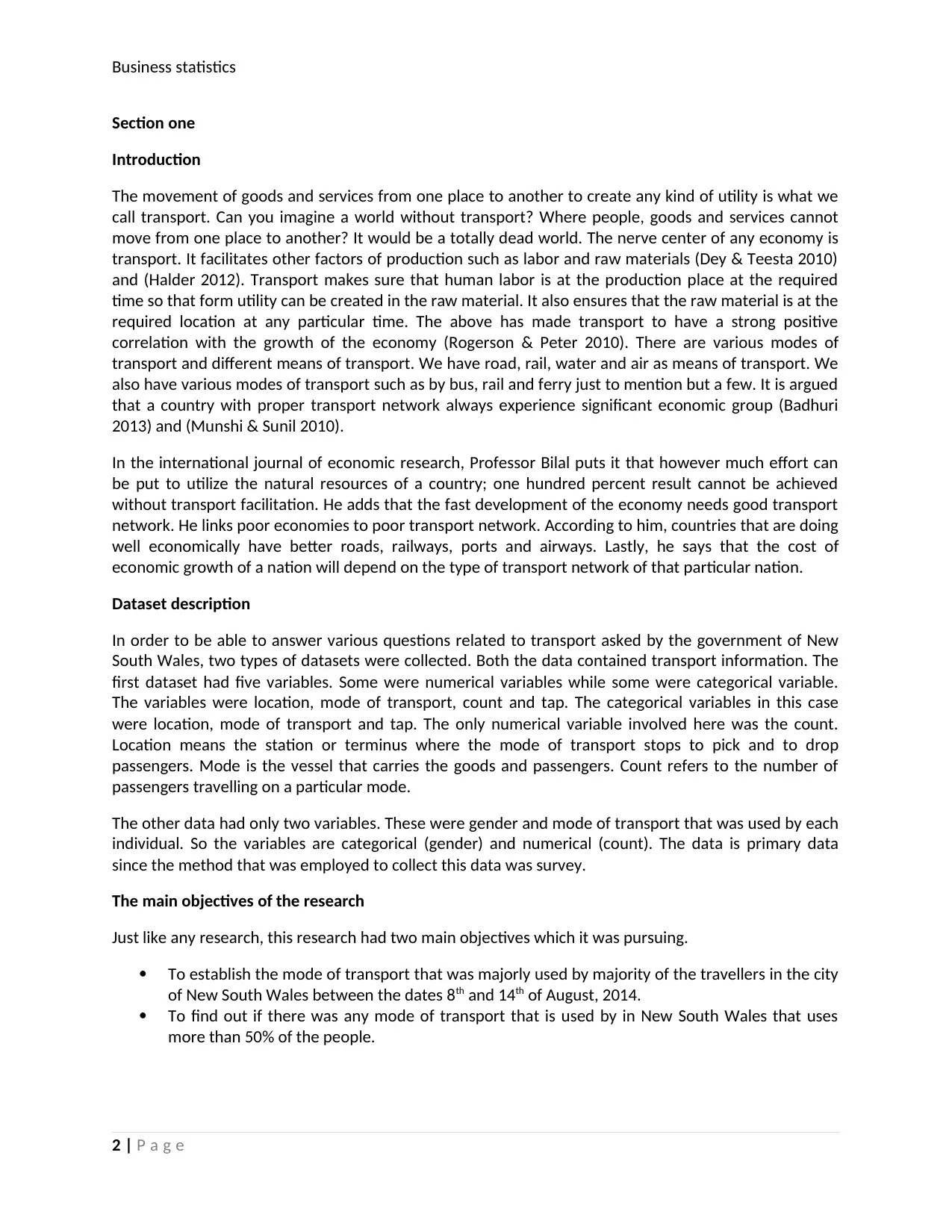
Business statistics
Section one
Introduction
The movement of goods and services from one place to another to create any kind of utility is what we
call transport. Can you imagine a world without transport? Where people, goods and services cannot
move from one place to another? It would be a totally dead world. The nerve center of any economy is
transport. It facilitates other factors of production such as labor and raw materials (Dey & Teesta 2010)
and (Halder 2012). Transport makes sure that human labor is at the production place at the required
time so that form utility can be created in the raw material. It also ensures that the raw material is at the
required location at any particular time. The above has made transport to have a strong positive
correlation with the growth of the economy (Rogerson & Peter 2010). There are various modes of
transport and different means of transport. We have road, rail, water and air as means of transport. We
also have various modes of transport such as by bus, rail and ferry just to mention but a few. It is argued
that a country with proper transport network always experience significant economic group (Badhuri
2013) and (Munshi & Sunil 2010).
In the international journal of economic research, Professor Bilal puts it that however much effort can
be put to utilize the natural resources of a country; one hundred percent result cannot be achieved
without transport facilitation. He adds that the fast development of the economy needs good transport
network. He links poor economies to poor transport network. According to him, countries that are doing
well economically have better roads, railways, ports and airways. Lastly, he says that the cost of
economic growth of a nation will depend on the type of transport network of that particular nation.
Dataset description
In order to be able to answer various questions related to transport asked by the government of New
South Wales, two types of datasets were collected. Both the data contained transport information. The
first dataset had five variables. Some were numerical variables while some were categorical variable.
The variables were location, mode of transport, count and tap. The categorical variables in this case
were location, mode of transport and tap. The only numerical variable involved here was the count.
Location means the station or terminus where the mode of transport stops to pick and to drop
passengers. Mode is the vessel that carries the goods and passengers. Count refers to the number of
passengers travelling on a particular mode.
The other data had only two variables. These were gender and mode of transport that was used by each
individual. So the variables are categorical (gender) and numerical (count). The data is primary data
since the method that was employed to collect this data was survey.
The main objectives of the research
Just like any research, this research had two main objectives which it was pursuing.
To establish the mode of transport that was majorly used by majority of the travellers in the city
of New South Wales between the dates 8th and 14th of August, 2014.
To find out if there was any mode of transport that is used by in New South Wales that uses
more than 50% of the people.
2 | P a g e
Section one
Introduction
The movement of goods and services from one place to another to create any kind of utility is what we
call transport. Can you imagine a world without transport? Where people, goods and services cannot
move from one place to another? It would be a totally dead world. The nerve center of any economy is
transport. It facilitates other factors of production such as labor and raw materials (Dey & Teesta 2010)
and (Halder 2012). Transport makes sure that human labor is at the production place at the required
time so that form utility can be created in the raw material. It also ensures that the raw material is at the
required location at any particular time. The above has made transport to have a strong positive
correlation with the growth of the economy (Rogerson & Peter 2010). There are various modes of
transport and different means of transport. We have road, rail, water and air as means of transport. We
also have various modes of transport such as by bus, rail and ferry just to mention but a few. It is argued
that a country with proper transport network always experience significant economic group (Badhuri
2013) and (Munshi & Sunil 2010).
In the international journal of economic research, Professor Bilal puts it that however much effort can
be put to utilize the natural resources of a country; one hundred percent result cannot be achieved
without transport facilitation. He adds that the fast development of the economy needs good transport
network. He links poor economies to poor transport network. According to him, countries that are doing
well economically have better roads, railways, ports and airways. Lastly, he says that the cost of
economic growth of a nation will depend on the type of transport network of that particular nation.
Dataset description
In order to be able to answer various questions related to transport asked by the government of New
South Wales, two types of datasets were collected. Both the data contained transport information. The
first dataset had five variables. Some were numerical variables while some were categorical variable.
The variables were location, mode of transport, count and tap. The categorical variables in this case
were location, mode of transport and tap. The only numerical variable involved here was the count.
Location means the station or terminus where the mode of transport stops to pick and to drop
passengers. Mode is the vessel that carries the goods and passengers. Count refers to the number of
passengers travelling on a particular mode.
The other data had only two variables. These were gender and mode of transport that was used by each
individual. So the variables are categorical (gender) and numerical (count). The data is primary data
since the method that was employed to collect this data was survey.
The main objectives of the research
Just like any research, this research had two main objectives which it was pursuing.
To establish the mode of transport that was majorly used by majority of the travellers in the city
of New South Wales between the dates 8th and 14th of August, 2014.
To find out if there was any mode of transport that is used by in New South Wales that uses
more than 50% of the people.
2 | P a g e
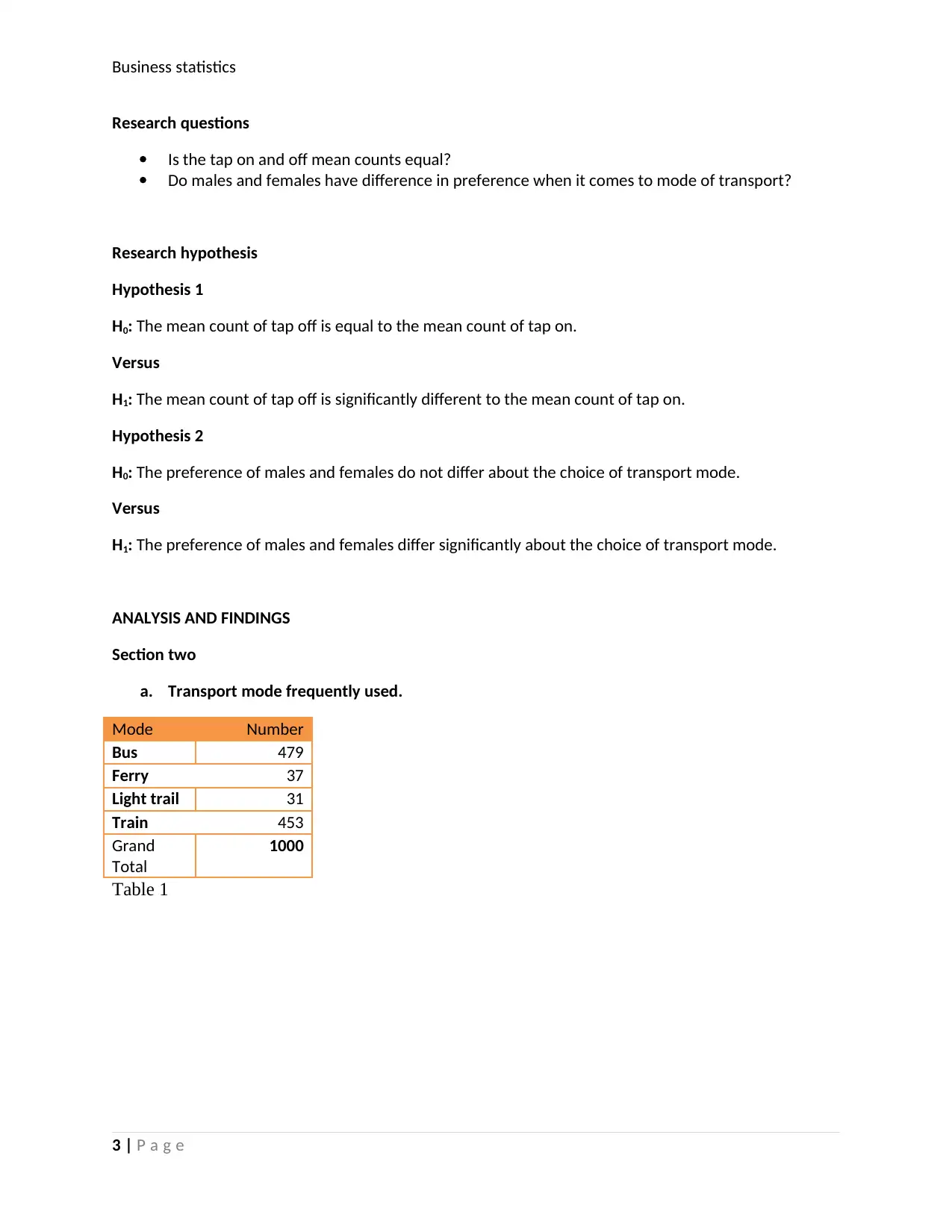
Business statistics
Research questions
Is the tap on and off mean counts equal?
Do males and females have difference in preference when it comes to mode of transport?
Research hypothesis
Hypothesis 1
H0: The mean count of tap off is equal to the mean count of tap on.
Versus
H1: The mean count of tap off is significantly different to the mean count of tap on.
Hypothesis 2
H0: The preference of males and females do not differ about the choice of transport mode.
Versus
H1: The preference of males and females differ significantly about the choice of transport mode.
ANALYSIS AND FINDINGS
Section two
a. Transport mode frequently used.
Mode Number
Bus 479
Ferry 37
Light trail 31
Train 453
Grand
Total
1000
Table 1
3 | P a g e
Research questions
Is the tap on and off mean counts equal?
Do males and females have difference in preference when it comes to mode of transport?
Research hypothesis
Hypothesis 1
H0: The mean count of tap off is equal to the mean count of tap on.
Versus
H1: The mean count of tap off is significantly different to the mean count of tap on.
Hypothesis 2
H0: The preference of males and females do not differ about the choice of transport mode.
Versus
H1: The preference of males and females differ significantly about the choice of transport mode.
ANALYSIS AND FINDINGS
Section two
a. Transport mode frequently used.
Mode Number
Bus 479
Ferry 37
Light trail 31
Train 453
Grand
Total
1000
Table 1
3 | P a g e
⊘ This is a preview!⊘
Do you want full access?
Subscribe today to unlock all pages.

Trusted by 1+ million students worldwide

Business statistics
bus ferry lightrail train
479
37 31
453
Mode of transport
Figure 1
The graph and table above represents how people travelled in New South Wales according to mode of
transport. 479 passengers used bus as a mode of transport. This number accounted for 47.9% of the
total. 453 passengers used bus as a mode of transport. This number accounted for 45.9% of the total. 37
passengers used ferry as a mode of transport. This number accounted for 37% of the total. 37
passengers used light rail as a mode of transport. This number accounted for 31% of the total. It
therefore follows from the results majority of the people in New South Wales travel by bus. The
government should therefore concentrate more in improving travelling by bus.
b. Is there more than 50% usage of modes of transport by public?
Hypothesis
H0: There is no mode of transport that is used by more than 50% of the public.
Versus
H1: There is a mode of transport that is used by more than 50% of the public.
Mode Number Percentag
e
bus 479 47.9%
ferry 37 3.7%
Light rail 31 3.1%
train 453 45.3%
Grand
Total
1000
Table 2
4 | P a g e
bus ferry lightrail train
479
37 31
453
Mode of transport
Figure 1
The graph and table above represents how people travelled in New South Wales according to mode of
transport. 479 passengers used bus as a mode of transport. This number accounted for 47.9% of the
total. 453 passengers used bus as a mode of transport. This number accounted for 45.9% of the total. 37
passengers used ferry as a mode of transport. This number accounted for 37% of the total. 37
passengers used light rail as a mode of transport. This number accounted for 31% of the total. It
therefore follows from the results majority of the people in New South Wales travel by bus. The
government should therefore concentrate more in improving travelling by bus.
b. Is there more than 50% usage of modes of transport by public?
Hypothesis
H0: There is no mode of transport that is used by more than 50% of the public.
Versus
H1: There is a mode of transport that is used by more than 50% of the public.
Mode Number Percentag
e
bus 479 47.9%
ferry 37 3.7%
Light rail 31 3.1%
train 453 45.3%
Grand
Total
1000
Table 2
4 | P a g e
Paraphrase This Document
Need a fresh take? Get an instant paraphrase of this document with our AI Paraphraser
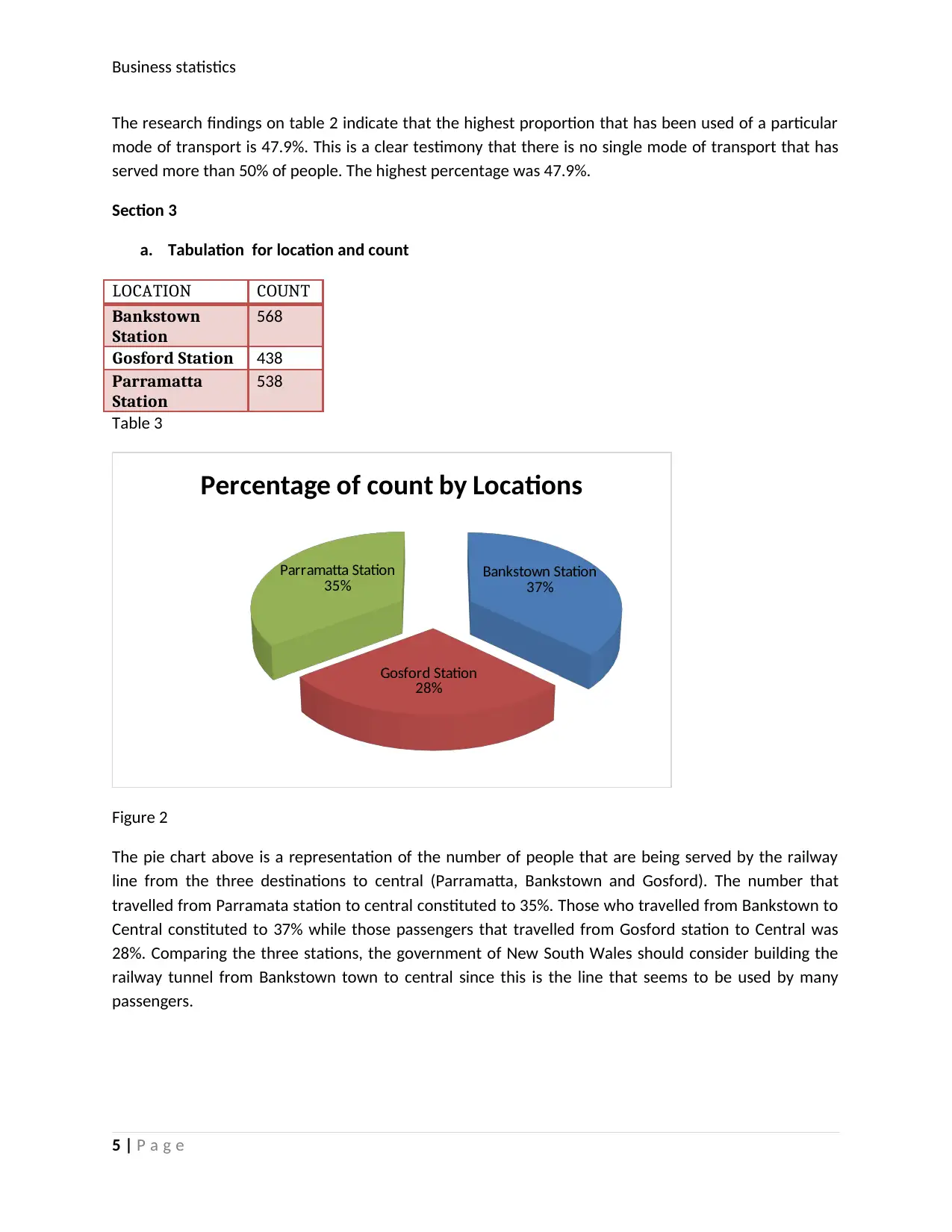
Business statistics
The research findings on table 2 indicate that the highest proportion that has been used of a particular
mode of transport is 47.9%. This is a clear testimony that there is no single mode of transport that has
served more than 50% of people. The highest percentage was 47.9%.
Section 3
a. Tabulation for location and count
LOCATION COUNT
Bankstown
Station
568
Gosford Station 438
Parramatta
Station
538
Table 3
Bankstown Station
37%
Gosford Station
28%
Parramatta Station
35%
Percentage of count by Locations
Figure 2
The pie chart above is a representation of the number of people that are being served by the railway
line from the three destinations to central (Parramatta, Bankstown and Gosford). The number that
travelled from Parramata station to central constituted to 35%. Those who travelled from Bankstown to
Central constituted to 37% while those passengers that travelled from Gosford station to Central was
28%. Comparing the three stations, the government of New South Wales should consider building the
railway tunnel from Bankstown town to central since this is the line that seems to be used by many
passengers.
5 | P a g e
The research findings on table 2 indicate that the highest proportion that has been used of a particular
mode of transport is 47.9%. This is a clear testimony that there is no single mode of transport that has
served more than 50% of people. The highest percentage was 47.9%.
Section 3
a. Tabulation for location and count
LOCATION COUNT
Bankstown
Station
568
Gosford Station 438
Parramatta
Station
538
Table 3
Bankstown Station
37%
Gosford Station
28%
Parramatta Station
35%
Percentage of count by Locations
Figure 2
The pie chart above is a representation of the number of people that are being served by the railway
line from the three destinations to central (Parramatta, Bankstown and Gosford). The number that
travelled from Parramata station to central constituted to 35%. Those who travelled from Bankstown to
Central constituted to 37% while those passengers that travelled from Gosford station to Central was
28%. Comparing the three stations, the government of New South Wales should consider building the
railway tunnel from Bankstown town to central since this is the line that seems to be used by many
passengers.
5 | P a g e
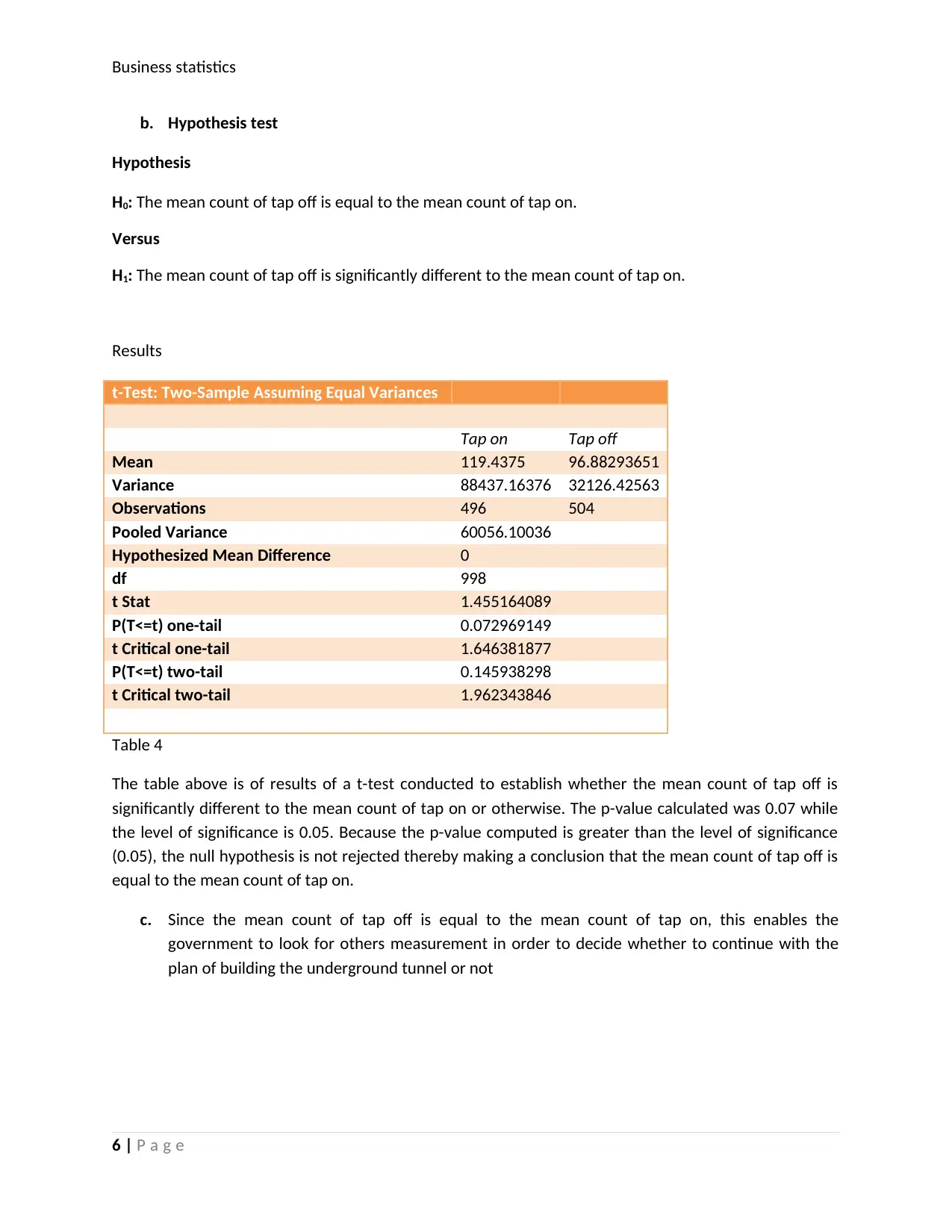
Business statistics
b. Hypothesis test
Hypothesis
H0: The mean count of tap off is equal to the mean count of tap on.
Versus
H1: The mean count of tap off is significantly different to the mean count of tap on.
Results
t-Test: Two-Sample Assuming Equal Variances
Tap on Tap off
Mean 119.4375 96.88293651
Variance 88437.16376 32126.42563
Observations 496 504
Pooled Variance 60056.10036
Hypothesized Mean Difference 0
df 998
t Stat 1.455164089
P(T<=t) one-tail 0.072969149
t Critical one-tail 1.646381877
P(T<=t) two-tail 0.145938298
t Critical two-tail 1.962343846
Table 4
The table above is of results of a t-test conducted to establish whether the mean count of tap off is
significantly different to the mean count of tap on or otherwise. The p-value calculated was 0.07 while
the level of significance is 0.05. Because the p-value computed is greater than the level of significance
(0.05), the null hypothesis is not rejected thereby making a conclusion that the mean count of tap off is
equal to the mean count of tap on.
c. Since the mean count of tap off is equal to the mean count of tap on, this enables the
government to look for others measurement in order to decide whether to continue with the
plan of building the underground tunnel or not
6 | P a g e
b. Hypothesis test
Hypothesis
H0: The mean count of tap off is equal to the mean count of tap on.
Versus
H1: The mean count of tap off is significantly different to the mean count of tap on.
Results
t-Test: Two-Sample Assuming Equal Variances
Tap on Tap off
Mean 119.4375 96.88293651
Variance 88437.16376 32126.42563
Observations 496 504
Pooled Variance 60056.10036
Hypothesized Mean Difference 0
df 998
t Stat 1.455164089
P(T<=t) one-tail 0.072969149
t Critical one-tail 1.646381877
P(T<=t) two-tail 0.145938298
t Critical two-tail 1.962343846
Table 4
The table above is of results of a t-test conducted to establish whether the mean count of tap off is
significantly different to the mean count of tap on or otherwise. The p-value calculated was 0.07 while
the level of significance is 0.05. Because the p-value computed is greater than the level of significance
(0.05), the null hypothesis is not rejected thereby making a conclusion that the mean count of tap off is
equal to the mean count of tap on.
c. Since the mean count of tap off is equal to the mean count of tap on, this enables the
government to look for others measurement in order to decide whether to continue with the
plan of building the underground tunnel or not
6 | P a g e
⊘ This is a preview!⊘
Do you want full access?
Subscribe today to unlock all pages.

Trusted by 1+ million students worldwide
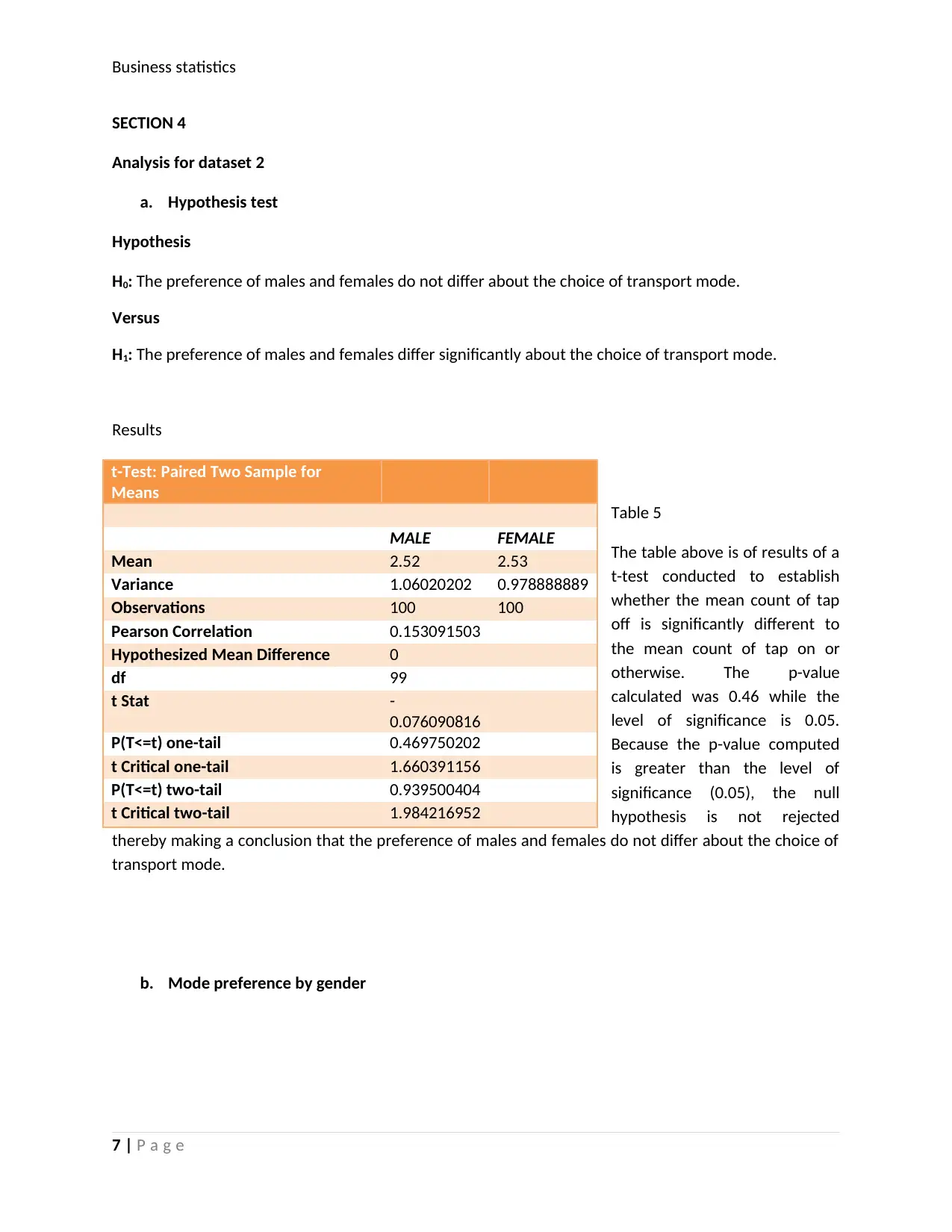
Business statistics
SECTION 4
Analysis for dataset 2
a. Hypothesis test
Hypothesis
H0: The preference of males and females do not differ about the choice of transport mode.
Versus
H1: The preference of males and females differ significantly about the choice of transport mode.
Results
Table 5
The table above is of results of a
t-test conducted to establish
whether the mean count of tap
off is significantly different to
the mean count of tap on or
otherwise. The p-value
calculated was 0.46 while the
level of significance is 0.05.
Because the p-value computed
is greater than the level of
significance (0.05), the null
hypothesis is not rejected
thereby making a conclusion that the preference of males and females do not differ about the choice of
transport mode.
b. Mode preference by gender
7 | P a g e
t-Test: Paired Two Sample for
Means
MALE FEMALE
Mean 2.52 2.53
Variance 1.06020202 0.978888889
Observations 100 100
Pearson Correlation 0.153091503
Hypothesized Mean Difference 0
df 99
t Stat -
0.076090816
P(T<=t) one-tail 0.469750202
t Critical one-tail 1.660391156
P(T<=t) two-tail 0.939500404
t Critical two-tail 1.984216952
SECTION 4
Analysis for dataset 2
a. Hypothesis test
Hypothesis
H0: The preference of males and females do not differ about the choice of transport mode.
Versus
H1: The preference of males and females differ significantly about the choice of transport mode.
Results
Table 5
The table above is of results of a
t-test conducted to establish
whether the mean count of tap
off is significantly different to
the mean count of tap on or
otherwise. The p-value
calculated was 0.46 while the
level of significance is 0.05.
Because the p-value computed
is greater than the level of
significance (0.05), the null
hypothesis is not rejected
thereby making a conclusion that the preference of males and females do not differ about the choice of
transport mode.
b. Mode preference by gender
7 | P a g e
t-Test: Paired Two Sample for
Means
MALE FEMALE
Mean 2.52 2.53
Variance 1.06020202 0.978888889
Observations 100 100
Pearson Correlation 0.153091503
Hypothesized Mean Difference 0
df 99
t Stat -
0.076090816
P(T<=t) one-tail 0.469750202
t Critical one-tail 1.660391156
P(T<=t) two-tail 0.939500404
t Critical two-tail 1.984216952
Paraphrase This Document
Need a fresh take? Get an instant paraphrase of this document with our AI Paraphraser
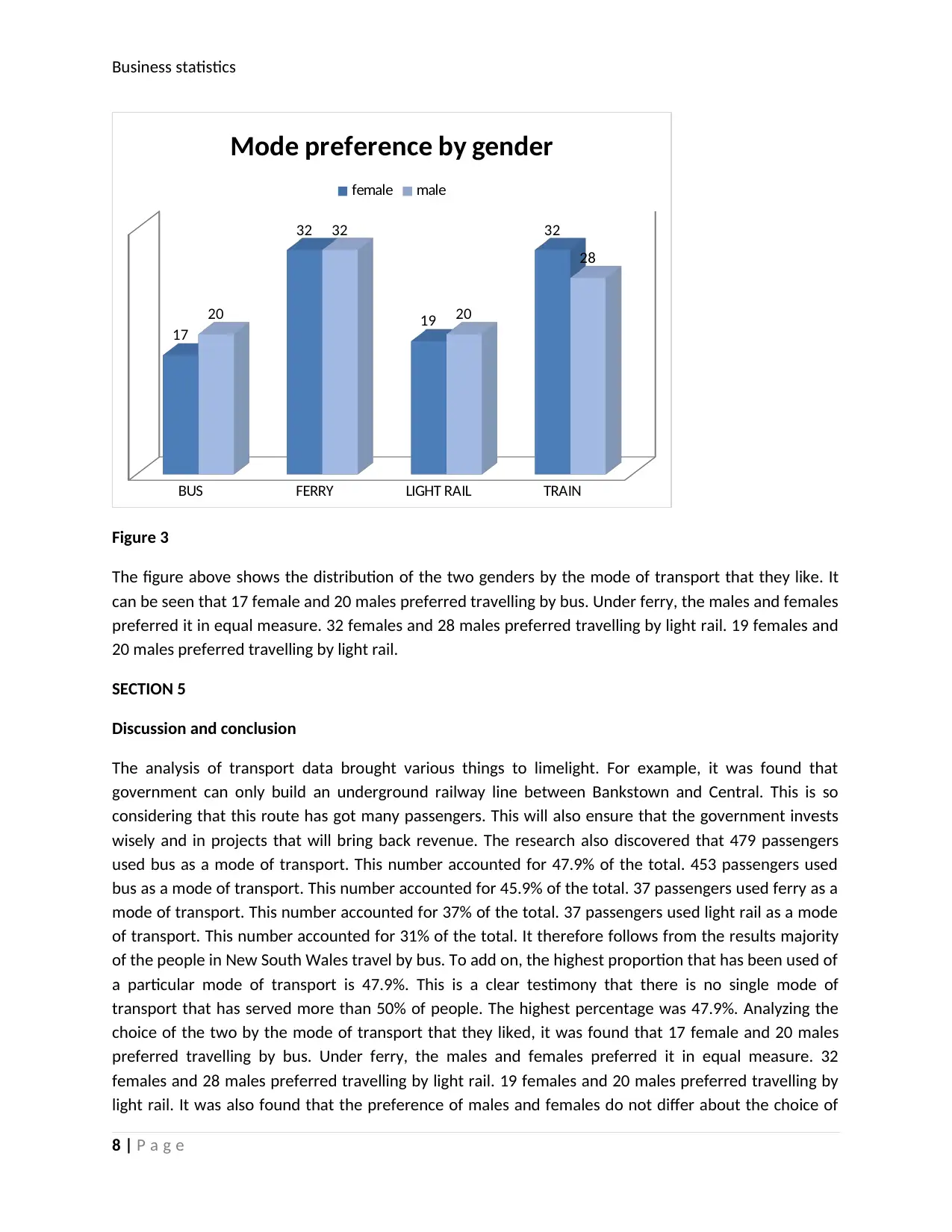
Business statistics
BUS FERRY LIGHT RAIL TRAIN
17
32
19
32
20
32
20
28
Mode preference by gender
female male
Figure 3
The figure above shows the distribution of the two genders by the mode of transport that they like. It
can be seen that 17 female and 20 males preferred travelling by bus. Under ferry, the males and females
preferred it in equal measure. 32 females and 28 males preferred travelling by light rail. 19 females and
20 males preferred travelling by light rail.
SECTION 5
Discussion and conclusion
The analysis of transport data brought various things to limelight. For example, it was found that
government can only build an underground railway line between Bankstown and Central. This is so
considering that this route has got many passengers. This will also ensure that the government invests
wisely and in projects that will bring back revenue. The research also discovered that 479 passengers
used bus as a mode of transport. This number accounted for 47.9% of the total. 453 passengers used
bus as a mode of transport. This number accounted for 45.9% of the total. 37 passengers used ferry as a
mode of transport. This number accounted for 37% of the total. 37 passengers used light rail as a mode
of transport. This number accounted for 31% of the total. It therefore follows from the results majority
of the people in New South Wales travel by bus. To add on, the highest proportion that has been used of
a particular mode of transport is 47.9%. This is a clear testimony that there is no single mode of
transport that has served more than 50% of people. The highest percentage was 47.9%. Analyzing the
choice of the two by the mode of transport that they liked, it was found that 17 female and 20 males
preferred travelling by bus. Under ferry, the males and females preferred it in equal measure. 32
females and 28 males preferred travelling by light rail. 19 females and 20 males preferred travelling by
light rail. It was also found that the preference of males and females do not differ about the choice of
8 | P a g e
BUS FERRY LIGHT RAIL TRAIN
17
32
19
32
20
32
20
28
Mode preference by gender
female male
Figure 3
The figure above shows the distribution of the two genders by the mode of transport that they like. It
can be seen that 17 female and 20 males preferred travelling by bus. Under ferry, the males and females
preferred it in equal measure. 32 females and 28 males preferred travelling by light rail. 19 females and
20 males preferred travelling by light rail.
SECTION 5
Discussion and conclusion
The analysis of transport data brought various things to limelight. For example, it was found that
government can only build an underground railway line between Bankstown and Central. This is so
considering that this route has got many passengers. This will also ensure that the government invests
wisely and in projects that will bring back revenue. The research also discovered that 479 passengers
used bus as a mode of transport. This number accounted for 47.9% of the total. 453 passengers used
bus as a mode of transport. This number accounted for 45.9% of the total. 37 passengers used ferry as a
mode of transport. This number accounted for 37% of the total. 37 passengers used light rail as a mode
of transport. This number accounted for 31% of the total. It therefore follows from the results majority
of the people in New South Wales travel by bus. To add on, the highest proportion that has been used of
a particular mode of transport is 47.9%. This is a clear testimony that there is no single mode of
transport that has served more than 50% of people. The highest percentage was 47.9%. Analyzing the
choice of the two by the mode of transport that they liked, it was found that 17 female and 20 males
preferred travelling by bus. Under ferry, the males and females preferred it in equal measure. 32
females and 28 males preferred travelling by light rail. 19 females and 20 males preferred travelling by
light rail. It was also found that the preference of males and females do not differ about the choice of
8 | P a g e
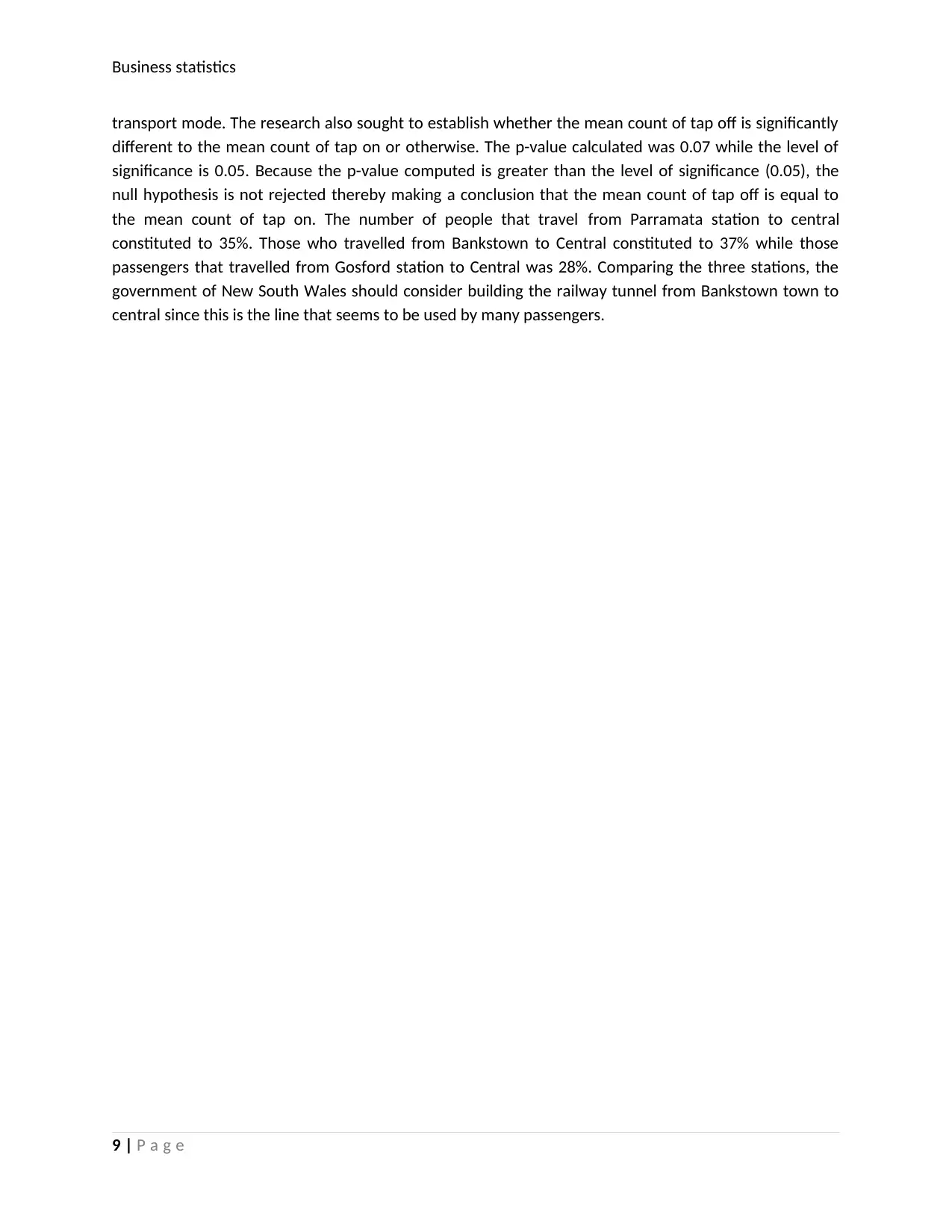
Business statistics
transport mode. The research also sought to establish whether the mean count of tap off is significantly
different to the mean count of tap on or otherwise. The p-value calculated was 0.07 while the level of
significance is 0.05. Because the p-value computed is greater than the level of significance (0.05), the
null hypothesis is not rejected thereby making a conclusion that the mean count of tap off is equal to
the mean count of tap on. The number of people that travel from Parramata station to central
constituted to 35%. Those who travelled from Bankstown to Central constituted to 37% while those
passengers that travelled from Gosford station to Central was 28%. Comparing the three stations, the
government of New South Wales should consider building the railway tunnel from Bankstown town to
central since this is the line that seems to be used by many passengers.
9 | P a g e
transport mode. The research also sought to establish whether the mean count of tap off is significantly
different to the mean count of tap on or otherwise. The p-value calculated was 0.07 while the level of
significance is 0.05. Because the p-value computed is greater than the level of significance (0.05), the
null hypothesis is not rejected thereby making a conclusion that the mean count of tap off is equal to
the mean count of tap on. The number of people that travel from Parramata station to central
constituted to 35%. Those who travelled from Bankstown to Central constituted to 37% while those
passengers that travelled from Gosford station to Central was 28%. Comparing the three stations, the
government of New South Wales should consider building the railway tunnel from Bankstown town to
central since this is the line that seems to be used by many passengers.
9 | P a g e
⊘ This is a preview!⊘
Do you want full access?
Subscribe today to unlock all pages.

Trusted by 1+ million students worldwide
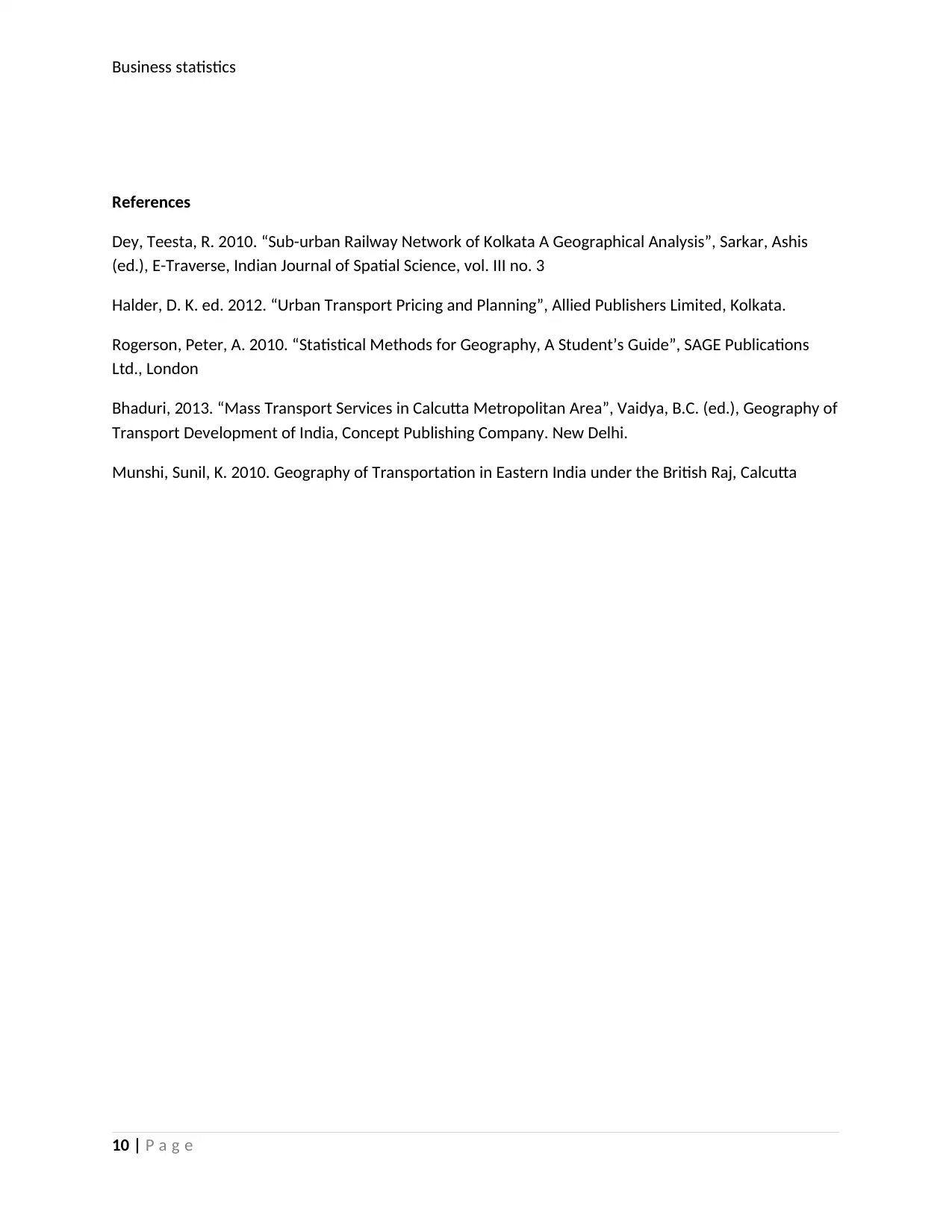
Business statistics
References
Dey, Teesta, R. 2010. “Sub-urban Railway Network of Kolkata A Geographical Analysis”, Sarkar, Ashis
(ed.), E-Traverse, Indian Journal of Spatial Science, vol. III no. 3
Halder, D. K. ed. 2012. “Urban Transport Pricing and Planning”, Allied Publishers Limited, Kolkata.
Rogerson, Peter, A. 2010. “Statistical Methods for Geography, A Student’s Guide”, SAGE Publications
Ltd., London
Bhaduri, 2013. “Mass Transport Services in Calcutta Metropolitan Area”, Vaidya, B.C. (ed.), Geography of
Transport Development of India, Concept Publishing Company. New Delhi.
Munshi, Sunil, K. 2010. Geography of Transportation in Eastern India under the British Raj, Calcutta
10 | P a g e
References
Dey, Teesta, R. 2010. “Sub-urban Railway Network of Kolkata A Geographical Analysis”, Sarkar, Ashis
(ed.), E-Traverse, Indian Journal of Spatial Science, vol. III no. 3
Halder, D. K. ed. 2012. “Urban Transport Pricing and Planning”, Allied Publishers Limited, Kolkata.
Rogerson, Peter, A. 2010. “Statistical Methods for Geography, A Student’s Guide”, SAGE Publications
Ltd., London
Bhaduri, 2013. “Mass Transport Services in Calcutta Metropolitan Area”, Vaidya, B.C. (ed.), Geography of
Transport Development of India, Concept Publishing Company. New Delhi.
Munshi, Sunil, K. 2010. Geography of Transportation in Eastern India under the British Raj, Calcutta
10 | P a g e
1 out of 10
Related Documents
Your All-in-One AI-Powered Toolkit for Academic Success.
+13062052269
info@desklib.com
Available 24*7 on WhatsApp / Email
![[object Object]](/_next/static/media/star-bottom.7253800d.svg)
Unlock your academic potential
Copyright © 2020–2025 A2Z Services. All Rights Reserved. Developed and managed by ZUCOL.



